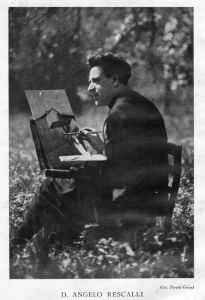Priest and painter
Don Angelo Rescalli, priest by vocation and painter by natural dowry, was born in Azzanello on 14 November 1884.
He entered the Episcopal Seminary of Cremona in 1897, was ordained priest in 1909 and sent as vicar to Vescovato and then to Olmeneta.
In those years Rescalli's passion for painting was born: he met the painters Vespasiano Bignami and. Vittore Grubicy from whom he drew the techniques of painting and the fundamentals of Divisionism.
In 1915, when Italy entered the war, he was called to arms and later sent to San Remo, where he became deputy chaplain in 1916 and chaplain in 1917.
Despite the end of hostilities and the requests for return from the Diocese of Cremona, Rescalli remained in Liguria where his painting career became more and more promising: he entered under the protection of two local noblewomen, Baroness Matilde Van Eys, who hosted him in her villa in Corso Cavallotti and whose private chapel he frescoed, and Countess Modesta Dell'Oro Hermil, who guaranteed him hospitality in her house in Susa, where he had a pagoda built as a painting studio.
In Sanremo he easily entered both the ecclesiastical and intellectual world. He took part in the constitution of the Sanremasca Artistic Family and together with Giuseppe Ferrari organised the Fourth Art Exhibition at Villa Ormond.
At the same time he carried out his ministry at the Parish of Santa Maria degli Angeli. Numerous were the cities that hosted exhibitions with his works. His continuous travels in Italy, France and the Netherlands allowed him to build up a very solid clientele and high-ranking knowledge: among these, General Luigi Cadorna and above all Prince Umberto II, with whom he was in a very cordial relationship for years. Some of his paintings were in fact purchased for the Savoy collections, and the Prince was for years a frequent presence at the inaugurations of the priest's personal exhibitions.
In 1940, on the wave of success, he moved to Rome. The precipitation of the political situation led him to take refuge in Susa.
At the end of the war, he tried to return to Rome, but discovered with bitterness that the property in his lodgings had been stolen, and he could not even regain possession of the property. The affair caused him great bitterness: the definitive withdrawal to Susa, the withdrawal from public life and the beginning of human and professional decline followed. Nevertheless, he was appointed honorary member of the Instituto de Cultura Americana de Tolosa (La Plata) in Argentina (1943) and Pontifical Academic by Pope Pius XII (1953).
He was a Divisionist painter, of the Segantini school but with a frank personal and original language.
He died in Susa on 10th December 1956.
(source : Marco Mauro)





